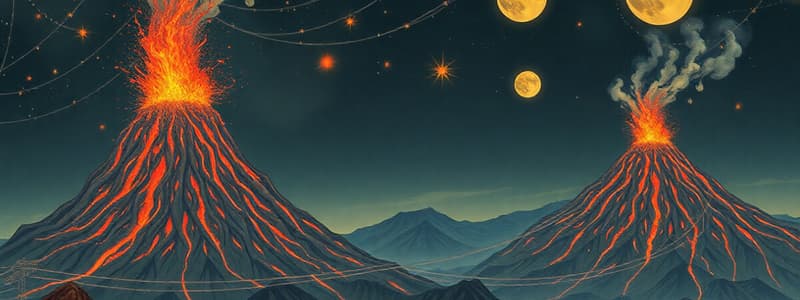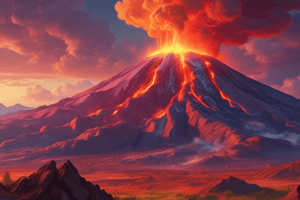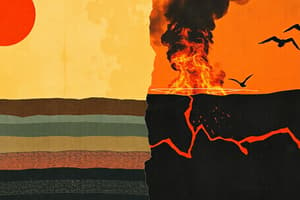Podcast
Questions and Answers
What geological feature is formed when the summit of a volcano collapses after an eruption?
What geological feature is formed when the summit of a volcano collapses after an eruption?
- Fumarole
- Magma chamber
- Crater (correct)
- Conduit
What is the name for the underground storage area of molten rock beneath a volcano?
What is the name for the underground storage area of molten rock beneath a volcano?
- Vent
- Conduit
- Fumarole
- Magma chamber (correct)
What is the function of a conduit in a volcano?
What is the function of a conduit in a volcano?
- To store volcanic gases
- To connect the magma chamber to the surface (correct)
- To form a bowl-shaped depression
- To emit steam
What geological feature emits volcanic gases such as steam near the summit of a volcano?
What geological feature emits volcanic gases such as steam near the summit of a volcano?
What is the Ring of Fire known for?
What is the Ring of Fire known for?
What process occurs at a subduction zone?
What process occurs at a subduction zone?
Why does magma form in subduction zones?
Why does magma form in subduction zones?
Volcanoes form as a result of what?
Volcanoes form as a result of what?
What is a characteristic of a dormant volcano?
What is a characteristic of a dormant volcano?
Why are cities near dormant volcanoes at risk?
Why are cities near dormant volcanoes at risk?
Which of the following is a reason why a volcano might become extinct?
Which of the following is a reason why a volcano might become extinct?
What is a typical feature of shield volcanoes?
What is a typical feature of shield volcanoes?
What is the primary composition of stratovolcanoes?
What is the primary composition of stratovolcanoes?
What type of eruption is typical of shield volcanoes?
What type of eruption is typical of shield volcanoes?
What is the cone shape of shield volcanoes?
What is the cone shape of shield volcanoes?
Which of the following volcanoes has a classic cone-shaped appearance?
Which of the following volcanoes has a classic cone-shaped appearance?
What geological feature is formed when tectonic plates move away from each other, allowing magma to rise?
What geological feature is formed when tectonic plates move away from each other, allowing magma to rise?
Which of the following is an example of a location where a subduction zone can be found?
Which of the following is an example of a location where a subduction zone can be found?
What process leads to the formation of underwater mountain chains at divergent boundaries?
What process leads to the formation of underwater mountain chains at divergent boundaries?
What geological feature creates chains of volcanoes as tectonic plates move over it?
What geological feature creates chains of volcanoes as tectonic plates move over it?
Which of the following is considered a sign that a volcano is active and may erupt soon?
Which of the following is considered a sign that a volcano is active and may erupt soon?
What is the Mid-Atlantic Ridge?
What is the Mid-Atlantic Ridge?
Which volcanic eruption type is characterized by a mixture of steam, ash, and fragments?
Which volcanic eruption type is characterized by a mixture of steam, ash, and fragments?
What is a potential positive effect of volcanic eruptions?
What is a potential positive effect of volcanic eruptions?
What causes the ocean floor to spread?
What causes the ocean floor to spread?
What is a pyroclastic flow?
What is a pyroclastic flow?
Which of the following is a characteristic of an active volcano?
Which of the following is a characteristic of an active volcano?
Which eruption type is named after a Roman historian?
Which eruption type is named after a Roman historian?
Which type of eruption commonly occurs in shield volcanoes and involves lava flows that travel long distances?
Which type of eruption commonly occurs in shield volcanoes and involves lava flows that travel long distances?
Which eruption type is known for frequent, small explosions and ejection of incandescent lava fragments?
Which eruption type is known for frequent, small explosions and ejection of incandescent lava fragments?
The Pelean eruption was first observed in 1944 on which volcano?
The Pelean eruption was first observed in 1944 on which volcano?
Which of these eruption columns can reach several tens of kilometers in height?
Which of these eruption columns can reach several tens of kilometers in height?
Which of the following is a characteristic of stratovolcanoes?
Which of the following is a characteristic of stratovolcanoes?
Which eruption type is known for being the most explosive?
Which eruption type is known for being the most explosive?
What type of eruption involves frequent, small explosions of cinders and lava?
What type of eruption involves frequent, small explosions of cinders and lava?
Which type of eruption is associated with the effusive flow of basaltic lava?
Which type of eruption is associated with the effusive flow of basaltic lava?
What causes Strombolian eruptions?
What causes Strombolian eruptions?
Which of these volcanoes is an example of a stratovolcano?
Which of these volcanoes is an example of a stratovolcano?
What characterizes Icelandic eruptions?
What characterizes Icelandic eruptions?
Which eruption type involves frequent, small explosions of cinders and lava?
Which eruption type involves frequent, small explosions of cinders and lava?
What geological feature can lava flows create?
What geological feature can lava flows create?
What characterizes Surtseyan eruptions?
What characterizes Surtseyan eruptions?
What is a lahar?
What is a lahar?
Which gas is commonly released during volcanic eruptions?
Which gas is commonly released during volcanic eruptions?
What negative impact can gases released during volcanic eruptions have on the environment?
What negative impact can gases released during volcanic eruptions have on the environment?
What beneficial effect can volcanic ash have on soil?
What beneficial effect can volcanic ash have on soil?
What resource can come from areas with volcanic activity?
What resource can come from areas with volcanic activity?
What positive effect can volcanos have on communities?
What positive effect can volcanos have on communities?
Flashcards
Volcanoes
Volcanoes
Openings in the Earth's crust where magma, gases, and ash erupt.
Caldera
Caldera
A bowl-shaped depression at the top of a volcano formed after an eruption.
Magma Chamber
Magma Chamber
Underground cavity where magma is stored before eruption.
Volcanic Conduit
Volcanic Conduit
Signup and view all the flashcards
Fumarole
Fumarole
Signup and view all the flashcards
Ring of Fire
Ring of Fire
Signup and view all the flashcards
Subduction Zones
Subduction Zones
Signup and view all the flashcards
Subduction
Subduction
Signup and view all the flashcards
Rift Zones
Rift Zones
Signup and view all the flashcards
Hot Spots
Hot Spots
Signup and view all the flashcards
Mid-Ocean Ridge Volcanoes
Mid-Ocean Ridge Volcanoes
Signup and view all the flashcards
Plate Boundaries
Plate Boundaries
Signup and view all the flashcards
Active Volcano
Active Volcano
Signup and view all the flashcards
Signs of Active Volcano
Signs of Active Volcano
Signup and view all the flashcards
Active Volcano
Active Volcano
Signup and view all the flashcards
Dormant Volcano
Dormant Volcano
Signup and view all the flashcards
Dormant Volcano Danger
Dormant Volcano Danger
Signup and view all the flashcards
Extinct Volcano
Extinct Volcano
Signup and view all the flashcards
Why Volcanoes Become Extinct
Why Volcanoes Become Extinct
Signup and view all the flashcards
Shield Volcano
Shield Volcano
Signup and view all the flashcards
Shield Volcano Eruptions
Shield Volcano Eruptions
Signup and view all the flashcards
Stratovolcano
Stratovolcano
Signup and view all the flashcards
Stratovolcano Eruptions
Stratovolcano Eruptions
Signup and view all the flashcards
Cinder Cone
Cinder Cone
Signup and view all the flashcards
Vulcanian Eruption
Vulcanian Eruption
Signup and view all the flashcards
Plinian Eruption
Plinian Eruption
Signup and view all the flashcards
Pelean Eruption
Pelean Eruption
Signup and view all the flashcards
Strombolian Eruption
Strombolian Eruption
Signup and view all the flashcards
Hawaiian Eruption
Hawaiian Eruption
Signup and view all the flashcards
Icelandic Eruption
Icelandic Eruption
Signup and view all the flashcards
Volcanic Soil Fertility
Volcanic Soil Fertility
Signup and view all the flashcards
Geothermal Energy
Geothermal Energy
Signup and view all the flashcards
Pyroclastic Flow
Pyroclastic Flow
Signup and view all the flashcards
Formation of New Landforms
Formation of New Landforms
Signup and view all the flashcards
Surtseyan Eruptions
Surtseyan Eruptions
Signup and view all the flashcards
Property damage from eruptions
Property damage from eruptions
Signup and view all the flashcards
Volcanic gas emissions
Volcanic gas emissions
Signup and view all the flashcards
Volcanic Soil Benefits
Volcanic Soil Benefits
Signup and view all the flashcards
Geothermal energy from volcanoes
Geothermal energy from volcanoes
Signup and view all the flashcards
Volcanic Tourism
Volcanic Tourism
Signup and view all the flashcards
Health impacts of volcanic ash
Health impacts of volcanic ash
Signup and view all the flashcards
Creation of new habitats
Creation of new habitats
Signup and view all the flashcards
Study Notes
- Volcanoes are openings in the Earth's crust where magma, gases, and ash erupt onto the surface.
- Volcanoes form due to tectonic activity, including subduction, rifting, and hot spots.
- Volcanoes are found worldwide in different shapes and sizes.
- Active volcanoes erupt frequently.
- Dormant or extinct volcanoes have not erupted in many years or thousands of years.
- When a volcano erupts, it can produce lava flows, ash clouds, and pyroclastic flows.
Parts of a Volcano
- Crater: A bowl-shaped depression at the top formed when the summit collapses after an eruption.
- Magma Chamber: Large underground cavity storing molten rock (magma).
- Conduit: A long, narrow channel connecting the magma chamber to the volcano's surface, where magma rises and erupts.
- Fumarole: A vent on the volcano's surface emitting steam, gas, and volcanic gases, usually found near the summit.
Location of Voucanoes
- The Ring of Fire, which is located in the Pacific Ocean, is a horseshoe-shaped region containing many of the world's most active volcanoes.
- The Ring of Fire stretches from Chile to Alaska, Japan, the Philippians, to New Zealand.
- The Ring of Fire contains an estimated 75% of the earth's volcanoes and experiences 90% of its earthquakes due to intense movement of tectonic plates.
Subduction Zones
- At a subduction zone, an oceanic plate (thinner, denser) is forced under a continental plate (thicker, lighter).
- As the oceanic plate sinks, it melts under high temperature and pressure to form magma, resulting in volcanoes.
- An example of this is the Andes Mountains in Chile and South America.
Rift Zones
- Rift zones develop when tectonic plates move apart from each other, which allows magma to rise and form volcanoes.
- Rift zones occur along continental rifts and mid-ocean ridges.
- An example of this is The East African Rift that contains Mount Nyiragongo.
Hot Spots
- A hot spot is a fixed area deep in the Earth where hot magma rises through the crust, creating volcanoes.
- These remain in place as tectonic plates move over them to form chains of volcanoes over time.
- The Hawaiian Islands in the middle of the Pacific Plate are an example of this.
Mid-Ocean Ridges
- The ocean floor spreads constantly at divergent boundaries (where plates pull apart).
- As plates separate, Magma then rises to fill the gap in the crust, which creates new oceanic crust and forming volcanoes.
- Over millions of years, underwater mountain chains have been developed out of this process
- The Mid-Atlantic Ridge is where the North American and Eurasian plates are moving apart, to slowly widen the Atlantic Ocean.
- Most Volcanoes are found along the edges of tectonic plates, where plates mostly collide, pull apart, or slide past each other.
- These areas are known as tectonic plate boundaries.
Volcanic Activity
- Active: A volcano is considered active if it is currently erupting, has erupted recently, or shows signs of erupting in the near future, with a direct connection to a magma source.
- Active volcanoes release steam, ash, gases (like sulfur dioxide), or lava, even when not fully erupting.
- Active Volcanoes include Mount Etna (Italy), Kilauea (Hawaii, USA) and Taal Volcano (Philippians).
- Increased earthquakes around the volcano are a sign that a Volcano is active and may erupt soon.
- Other signs include changes in sulfur dioxide emissions, bulging, swelling and temperature changes in hotsprings or crater lakes.
- Dormant: A dormant volcano has not erupted in a long time (hundreds or thousands of years) but has the potential to erupt again and retains a magma source.
- Mount Rainier (USA), Mount Fuji (Japan), and Mount Pinatubo (Philippines) are dormant volcanoes.
- Dormant volcanoes can be dangerous because people often build homes and cities nearby, as they seem inactive.
- Mount Vesuvius (Italy) was dormant before its catastrophic eruption in 79 AD, burying Pompeii and Herculaneum.
- Extinct: An extinct volcano has not erupted for thousands or millions of years, no longer connected to a magma source.
- Mount Kilimanjaro (Tanzania), Edinburgh Castle Rock (Scotland), and Shiprock (USA) are extinct volcanoes.
- Tectonic plate movement can cause this, which cuts of the magma supply of a hot spot volcano.
- Over time magma chambers also cool to extinguish Volcanic activity
- Additionally Weathering and Erosion can wear down volcanoes over time.
Types of Volcano
- Shield Volcanoes: Broad, gently sloping cone shape, formed by numerous lava flows spreading from a central vent. non-explosive, thin, runny lava flows. Examples include Mauna Loa and Kilauea in Hawaii.
- Stratovolcanoes: Tall, steep-sided volcanoes with a classic cone shape. Are formed by alternating layers of lava, ash, and volcanic debris. They can produce explosive eruptions and pyroclastic flows. Example include Mount Fuji (Japan) and Mount St. Helens (U.S.)
- Cinder Cones: Small, steep-sided volcanoes made of loose pyroclastic material such as ash, cinders, and volcanic bombs. They are formed by explosive eruptions ejecting material from a single vent. Examples include Mauna Kea (Hawaii) and Mount Etna (Italy).
Types of Volcanic Eruptions
- Volcanic eruptions occur when magma rises to the surface and erupts through a vent in Earth's crust.
- Types of volcanic eruptions can be classified based on the magma, gas in magma, and style of eruption.
- Vulcanian Eruptions eject large amounts of ash, gas, and rock fragments into the air. The eruption column can reach several kilometers high with travelling ash.
- Plinian Eruptions are the most explosive type of volcanic eruption, erupting large amounts of ash, gas, and pumice, which forms a mushroom-shaped cloud reaching tens of kilometers into the atmosphere.
- Pelean Eruptions have blocked volcanic vents causing building pressure released in violent explosions and result in pyroclastic flow, and can be extremely destructive and travel at hundreds of kilometers per hour.
- Strombolian Eruptions are characterized by frequent, small explosions ejecting cinders, ash, and molten lava due to gas bubbles in the magma.
- Hawaiian Eruptions are characterized by the effusive eruption of basaltic lava, spreading lava over a large area to form shield volcanoes and non-explosive, steadily, and slowly flowing lavas.
- Icelandic Eruptions are typically non-explosive with lava flowing out of fissures or vents in the Earth's crust, creating vast lava fields and shield volcanoes.
- Surtseyan Eruptions occur when magma interacts with water, leading to explosive eruptions of steam, ash, and rock fragments and rapidly expanding steam-filled cavities.
Effects of Volcanic Eruptions
- Volcanic eruptions can cause property damage to buildings, infrastructure, and agricultural land, particularly through lava flows, pyroclastic flows, or lahars (mudflows).
- Water pollution can occur from the release of ash and other materials that impacts aquatic life.
- Air pollution can occur from the release of gases such as sulfur dioxide and carbon dioxide into the atmosphere, leading to the formation of acid rain and smog.
- Inhaled ash and particles can be harmful to human health, causing/aggravating respiratory problems.
- Volcanic ash is rich in minerals and can provide nutrient-rich soil for plant growth, such as the island of Hawaii.
- Volcanic activity can produce geothermal energy for electricity generation and heating, which provides a clean and sustainable energy source.
- New landforms can provide habitats for plants and animals and support new ecosystems.
- Volcanoes and associated features such as hot springs, geysers, and lava fields are popular tourist attractions that bring economic benefits to local communities.
Studying That Suits You
Use AI to generate personalized quizzes and flashcards to suit your learning preferences.




